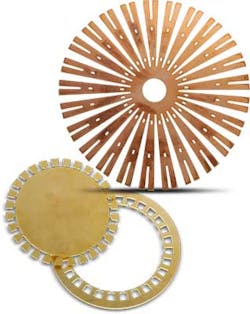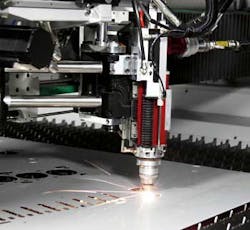RICKY HANSSON
In the winter of 2007 to 2008, Salvagnini began investigating the potential of applying fiber laser technology to cutting sheet metal. The company, like many others, had been heavily invested in the manufacture and marketing of CO2 laser cutting machines, but management recognized that as a product category, CO2 lasers were approaching the mature product stage, with any advances in technology being few in number and incremental in nature. In fact, much of the company’s success in laser sales stemmed as much from its expertise in automating the laser cutting process with products like its parts picker/sorter/stacker—the industry’s first—as it did for the laser itself (see FIGURE 1). Salvagnini thought the market wanted something new, something better, and the more the company’s R&D team members dug into the Fiber Project, the more excited they became.
Initial research using an IPG Photonic fiber laser demonstrated unprecedented speeds when cutting thinner materials, and at least comparable speeds when cutting thicker materials. CO2 lasers continued to perform best on the thickest materials, but for the bulk of the sheet metal fabrication market, fiber laser technology seemed to be well suited. In addition to speed, the cost of operation was as much as five times lower than CO2 lasers, which meant the payback time was reduced and ROI would be greater for owners of fiber laser cutters. When the initial studies were complete, the future was clear—Salvagnini would go with fiber lasers.
First fiber laser cutter
During the first part of 2008, company engineers designed and assembled the company’s first fiber laser cutter using an IPG fiber laser source based on the architecture of its L1 CO2 laser system. The result was a machine that required no warm-up, no laser gases, no mirror realignments, but owing to its 1 µm wavelength, it was capable of cutting highly reflective materials such as copper, brass, aluminum, and galvanized steel. With test results in hand that proved a 2 kW fiber laser could outperform a 4kW CO2 laser in almost every category, the designers and engineers set about building a commercial fiber laser cutter.
The L1Xe fiber laser was introduced to the world at EuroBlech in October 2008 and to the US market at FabTech 2009. Salvagnini shipped its first fiber laser cutter in March 2009 and over the course of the following 2.5 years has created a base of over 130 installed machines around the world. In 2010, the company introduced a second generation of laser systems at 2 and 3 kW that were not based on an earlier CO2 chassis, but one designed to accommodate the specifics and take full advantage of the technology.
The 70% solution
Ever since lasers were introduced for cutting sheet metal, CO2 lasers have occupied the lion’s share of the market. However, fiber lasers have captured an increasingly large share of new sales. The simplicity of a fiber laser versus a CO2 laser can be seen with the naked eye; the machine footprint of a fiber laser is smaller. The laser source and chiller are smaller. Laser gas lines have disappeared, and there are no mirrors to align. And yet a 2 kW or 3 kW fiber laser source can do the same amount of work as a 4 kW or 6 kW CO2 laser, and do it faster, with less energy consumption and with less environmental impact.
The key lies with the laser source. A CO2 laser source requires a lot of power to excite N2 molecules to create collisions with CO2 molecules (the laser gas), causing them to emit photons that are ultimately focused to form a laser beam capable of cutting through metal. Stimulating molecules in the resonator releases heat as well as light, which requires a chiller to cool off the laser gases. That means more power is consumed in the cooling process, with a further reduction in efficiency.
Fiber lasers, on the other hand, employ solid-state diodes to pump molecules that are captured in an optical active double clad fiber with an ytterbium-doped core. The pumped light excites the core, and the light exits the module via a transport optical fiber that carries the beam to the focusing head where cutting takes place. The need for laser gas is eliminated as all collisions between molecules take place within the optical fiber, which in turn requires far less energy—about one-third that of a comparable CO2 laser. And because less heat is generated, the size of the chiller is proportionally reduced. In general, overall energy consumption is 70% less than a CO2 laser performing the same task.Where does it fit into a modern shop?
Fiber lasers are very versatile, efficient machine tools that shops of all sizes and levels of sophistication are finding to be one of their most valuable assets. For those cutting a variety of materials and thicknesses, Salvagnini L3 (FIGURE 2) and L5 (FIGURES 3 and 4) machines are capable of cutting steel up to 0.70 inches thick, stainless up to 0.394 inch, aluminum to 0.315 inch, and copper and brass to 0.197 inch with no lens change.Speed and versatility are vital in a manufacturing environment because work-in-process adds cost to the final product. But there are other costs that factor into the profitability equation. For example, total operating costs for a Salvagnini fiber laser cutter are about 56 cents an hour compared to $3.19 an hour for a typical CO2 laser. What’s more, with no mirrors to keep in alignment, no blowers to replace, no resonators to tune, and no laser gas to replace, maintenance costs are negligible or non-existent. And with a laser source that is predicted to last 100,000 hours—five times longer than a CO2 resonator—both replacement costs and the cost of downtime are eliminated. All things considered, a fiber laser can cut twice as fast at one-sixth the cost, with a typical payback period that is only 70% of that of a CO2 laser.
Last, but not least, part quality benefits from a very stable beam platform that remains constant and maintains cut quality, even if there is variation in the distance between the nozzle and the sheet being cut, owing to any unevenness in the surface of the metal. And because of the fiber laser’s small spot size and narrow kerf width, high speed cutting is achieved without sacrificing high cut quality. That means reduced scrap and superior quality finished parts.
The future in sheet metal cutting
In 2008, very few companies saw the potential of fiber laser cutting (or were unwilling to admit it), but since then most major systems manufacturers have developed some form of fiber laser cutter. But as history reminds us, technology never stands still. Solid-state diode sources are scalable, and power packages as massive as 50 kW have already been assembled for other applications, although that would obviously be overkill for sheet metal cutting. So power is not a problem. Others are working on improved optics that will enable the cutting of greater thicknesses. Until recently, cutting through film has been difficult, but the solution to that problem has been proposed, and success is imminent. As improvements are implemented and capacity is increased, it becomes only a matter of time until fiber lasers may challenge CO2 lasers in annual sales.
Ricky Hansson ([email protected]) is VP applications and project management at Salvagnini America Inc.



